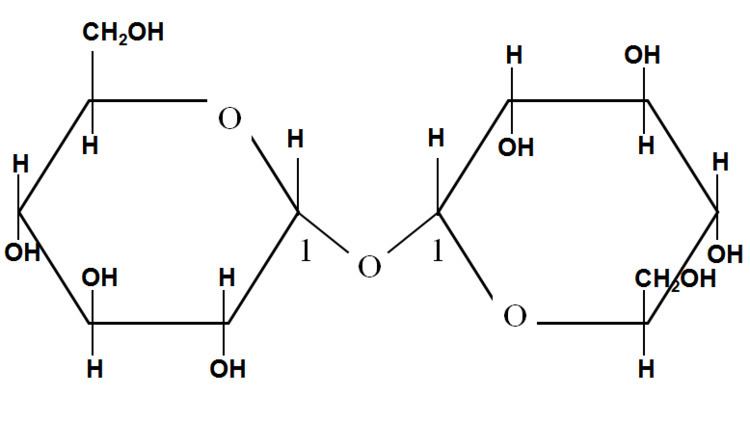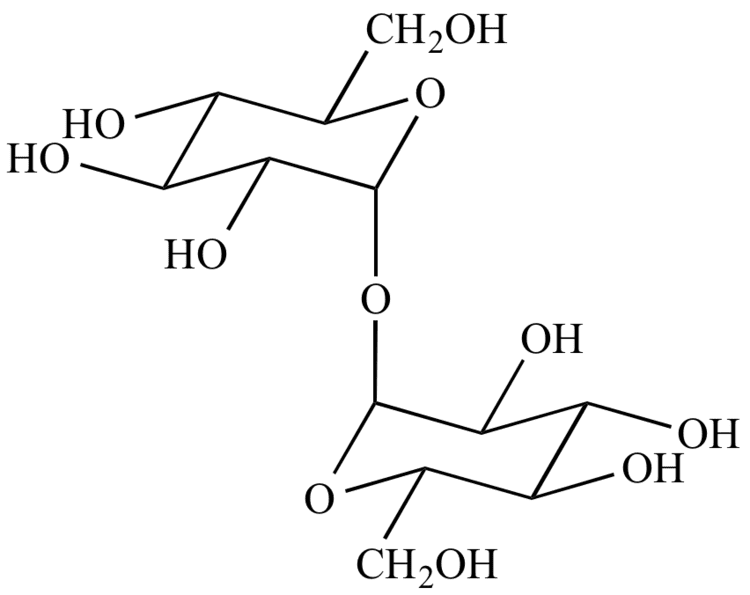Formula C12H22O11 Density 1.58 g/cm3 at 24 °C | UNII B8WCK70T7I | |
 | ||
Appearance White orthorhombic crystals Melting point 203 °C (397 °F; 476 K) (anhydrous); 97 °C (dihydrate) | ||
Treha trehalose
Trehalose, also known as mycose or tremalose, is a natural alpha-linked disaccharide formed by an α,α-1,1-glucoside bond between two α-glucose units. In 1832, H.A.L. Wiggers discovered trehalose in an ergot of rye, and in 1859 Marcellin Berthelot isolated it from trehala manna, a substance made by weevils, and named it trehalose. It can be synthesised by bacteria, fungi, plants, and invertebrate animals. It is implicated in anhydrobiosis — the ability of plants and animals to withstand prolonged periods of desiccation. It has high water retention capabilities, and is used in food and cosmetics. The sugar is thought to form a gel phase as cells dehydrate, which prevents disruption of internal cell organelles, by effectively splinting them in position. Rehydration then allows normal cellular activity to be resumed without the major, lethal damage that would normally follow a dehydration/rehydration cycle. Trehalose is not an antioxidant, because it is a non-reducing sugar and does not contain nucleophilic groups in its molecule. However, it was reported to have antioxidant effects.
Contents
- Treha trehalose
- Trehalose
- Structure
- Chemical properties
- Nutritional and dietary properties
- Biological properties
- Use to treat amyloidosis
- Other possible benefits
- References

Extracting trehalose was once a difficult and costly process, but circa the year 2000, the Hayashibara company (Okayama, Japan) confirmed an inexpensive extraction technology from starch for mass production.

Trehalose is used in a broad spectrum of applications.
Trehalose
Structure

Trehalose is a disaccharide formed by a 1,1-glucoside bond between two α-glucose units. Because trehalose is formed by the bonding of two reducing aldehyde groups, it has no capacity to participate in the Maillard reaction. There is an industrial process where trehalose is derived from corn starch. There are at least 3 biological pathways for trehalose biosynthesis.
Chemical properties

Trehalose is a nonreducing sugar formed from two glucose units joined by a 1-1 alpha bond, giving it the name of α-D-glucopyranosyl-(1→1)-α-D-glucopyranoside. The bonding makes trehalose very resistant to acid hydrolysis, and therefore is stable in solution at high temperatures, even under acidic conditions. The bonding also keeps nonreducing sugars in closed-ring form, such that the aldehyde or ketone end groups do not bind to the lysine or arginine residues of proteins (a process called glycation). Trehalose is less soluble than sucrose, except at high temperatures (>80 °C). Trehalose forms a rhomboid crystal as the dihydrate, and has 90% of the calorific content of sucrose in that form. Anhydrous forms of trehalose readily regain moisture to form the dihydrate. Anhydrous forms of trehalose can show interesting physical properties when heat-treated.
Trehalose aqueous solutions show a concentration-dependent clustering tendency. Owing to their ability to form hydrogen bonds between one another, they self-associate in water to form clusters of various sizes. All-atom molecular dynamics simulations have shown that when reaching a concentration of 1.5-2.2 molar, the trehalose molecular clusters percolate and form large, continuous aggregates within the system.
Trehalose directly interacts with nucleic acids, facilitates melting of double stranded DNA and stabilizes single-stranded nucleic acids.
Nutritional and dietary properties
Trehalose is nutritionally equivalent to glucose, because it is rapidly broken down into glucose by the enzyme trehalase, which is present in the brush border of the intestinal mucosa of omnivores (including humans) and herbivores.p. 135 Trehalase deficiency is unusual in humans, except in the Greenlandic Inuit, where it occurs in 10%-15% of the population.p. 197 Trehalose has about 45% the sweetness of sucrose at concentrations above 22%, but when the concentration is reduced, its sweetness decreases more quickly than that of sucrose, so that a 2.3% solution tastes 6.5 times less sweet as the equivalent sugar solution.p. 444
Biological properties
In nature, trehalose can be found in animals, plants, and microorganisms. In animals, trehalose is prevalent in shrimp, and also in insects, including grasshoppers, locusts, butterflies, and bees, in which blood-sugar is trehalose. The trehalose is then broken down into glucose by the catabolic enzyme trehalase for use. Trehalose is also present in the nutrition exchange liquid of hornets and their larvae.
Trehalose is the major carbohydrate energy storage molecule used by insects for flight. One possible reason for this is that the glycosidic linkage of trehalose, when acted upon by an insect trehalase, releases two molecules of glucose, which is required for the rapid energy requirements of flight. This is double the efficiency of glucose release from the storage polymer starch, for which cleavage of one glycosidic linkage releases only one glucose molecule.
In plants, the presence of trehalose is seen in sunflower seeds, moonwort, Selaginella plants, and sea algae. Within the fungi, it is prevalent in some mushrooms, such as shiitake (Lentinula edodes), oyster, king oyster, golden needle, maitake (Grifola fondosa), nameko (Pholiota nameko), and Judas's ear (Auricularia auricula-judae), which can contain 1% to 17% percent of trehalose in dry weight form (thus it is also referred to as mushroom sugar). Trehalose can also be found in such microorganisms as baker's yeast and wine yeast, and it is metabolized by a number of bacteria, including Streptococcus mutans, the common oral bacterium responsible for dental plaque.
When tardigrades (water bears) dry out, the glucose in their bodies changes to trehalose when they enter a state called cryptobiosis — a state wherein they appear dead. However, when they receive water, they revive and return to their metabolic state. It is also thought that the reason the larvae of sleeping chironomid (Polypedilum vanderplanki) and artemia (sea monkeys, brine shrimp) are able to withstand dehydration is because they store trehalose within their cells.
Even within the plant kingdom, Selaginella (sometimes called the resurrection plant), which grows in desert and mountainous areas, may be cracked and dried out, but will turn green again and revive after a rain because of the function of trehalose. It is also said that the reason dried shiitake mushrooms spring back into shape so well in water is because they contain trehalose.
The two prevalent theories as to how trehalose works within the organism in the state of cryptobiosis are the vitrification theory, a state that prevents ice formation, or the water displacement theory, whereby water is replaced by trehalose, although it is possible that a combination of the two mechanisms is at work.
Use to treat amyloidosis
Trehalose induces autophagy via an mTOR independent pathway. Trehalose activates TFEB, a master controller of lysosomal biogenesis and autophagy, by inhibiting AKT/PKB, which is a negative regulator of TFEB that acts by direct phosphorylation (and inhibition) of TFEB. It may have use for treatments of Huntington's disease, Parkinson disease, tauopathies or Batten disease, as it may correct defects in autophagy seen in these diseases and improve removal of aggregated proteins and other aberrant storage material.
Other possible benefits
Oral trehalose shows antidepressant properties in the mouse model of depression, possibly through reducing p62/Beclin-1 ratio and increasing autophagy in the frontal cortex. It also prevents fructose from entering the liver and may trigger autophagy of high-fat liver cells, leading to a possible treatment for fatty liver disease.
Trehalose has been combined with hyaluronic acid to create a novel artificial tear (Thealoz Duo) to treat dry eye.
